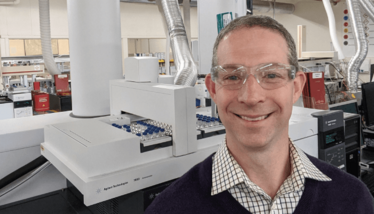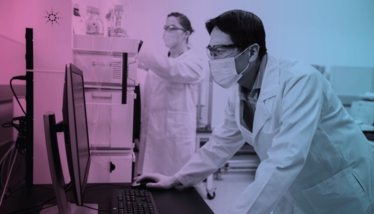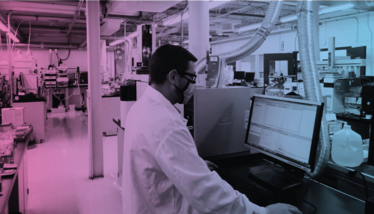
Extracting Sense From E&L Science
Mark Jordi, President of Jordi Labs, discusses the latest in extractables and leachables science, including changes in the regulatory landscape and recent advances in methods for the identification and quantitation of leachables

Give us the quick lowdown on E&L…
Leachables are substances that come from – or “leach” out of – pharmaceutical packaging or manufacturing components and enter the drug product, resulting in patient exposure. Leachables can also stem from medical devices and transfer to the patient through contact with the medical device, either directly or indirectly. Extractables are substances that are observed to extract under laboratory conditions. Put another way, extractables are the components that may come out of a medical product, while leachables are compounds that do come out.
E&L analysis for drug products is required by regulators, including the FDA: “Drug product containers and closures shall not be reactive, additive, or absorptive so as to alter the safety, identity, strength, quality or purity of the drug beyond the official or established requirements”(1). The goal of E&L analysis is to protect patient safety and support drug and device manufacturers by identifying toxic leachables before they reach the patient.
What guidance exists for E&L analyses?
2020 has been an exciting year in the world of E&L analysis because of significant changes in the landscape of available guidance. A partial list of the current US Pharmacopeia (USP) chapters that provide E&L guidance include:
- <87> Biological Reactivity Tests, in Vitro
- <88> Biological Reactivity Tests, in Vivo
- <381> Elastomeric Closure for Injections
- <232> Elemental Impurities - Limits
- <233> Elemental Impurities - Procedures
- <661> Plastic Packaging Systems and Their Materials of Construction
- <661.1> Plastic Materials of Construction
- <661.2> Plastic Packaging Systems for Pharmaceutical Use
- <1031> The Biocompatibility of Materials Used in Drug Containers, Medical Devices and Implants
- <1661> Evaluation of Plastic Packaging Systems for Pharmaceutical Use ad Their Materials of Construction
- <1663> Assessment of Extractables Associated with Pharmaceutical Packaging/Delivery Systems
- <1664> Assessment of Drug Product Leachables Associated with Pharmaceutical Packaging/Delivery Systems
Two additional USP chapters are also in development: <665> Plastic Materials, Components, and Systems Used in the Manufacturing of Pharmaceutical Drug Products and Biopharmaceutical Drug Substances and Products, and <1665> Characterization of Plastic Materials, Components and Systems Used in the Manufacturing of Pharmaceutical Drug Products and Biopharmaceutical Drug Substances and Products.
Chapters under revision include USP <661>, <661.1>, <661.2>, <1661> – December 1, 2025 is the scheduled implementation date for these revisions.
Though the USP chapters provide significant guidance, other sources of guidance also exist, such as the Product Quality Research Institute (PQRI) recommendations on orally inhaled and nasal drug products (OINDP): “Safety Threshold and Best Practices for Extractables and Leachables in Orally Inhaled and Nasal Drug Products.” PQRI is also working on another document specific to parenteral and ophthalmic drug products.
Meanwhile, the BioPhorum Operation Group (BPOG) has published a revised document this year entitled “Extractables Testing of Polymeric Single-use Components used in Biopharmaceutical Manufacturing,” which streamlines their testing recommendations. There is also ISO 18562, “Biocompatibility evaluation of breathing gas pathways in healthcare applications,” and ICH has provided guidance applicable to E&L as a part of Q3C Residual Solvents and Q3D: Elemental Impurities. In July 2020, ICH also released a concept paper describing a new proposed guidance, Q3E, entitled “Guideline for Extractables and Leachables (E&L)” (2). This discussion has not included the EU guidance documents, but I think it’s clear that the guidance for E&L of pharmaceutical products is rich and continues to expand.
In my opinion, the biggest news this year for E&L was the release of the much-anticipated ISO 10993-18:2020 medical device guidance, which became an FDA recognized consensus standard. This document provides a much greater degree of clarity surrounding best practices for E&L analysis of medical devices.
The document begins with a general description of the chemical characterization process. It then details the role and methods for obtaining information on the materials of construction, and for conducting compositional profiling as a starting point for E&L analysis. The document then provides an overview of the E&L process, with guidance for assessing worst-case chemical release, establishing the analytical evaluation threshold (AET), and estimating chemical release using extractables studies and determining the actual release by subsequent leachables assessments.
The next significant section provides recommendations for the chemical characterization process, including selection of analytical techniques, the role of structural composition analysis, analytical methods and their qualification, and even reporting practices. It is then further supplemented with no less than seven annexes, providing an in-depth discussion on topics ranging from general principles of chemical characterization, extraction theory, qualification of analytical methods, and calculation of the analytical evaluation threshold (AET). This document also includes a great series of flow charts summarizing the chemical characterization process. It is by far the most comprehensive guidance for medical devices to date.
Can you tell us more about the importance of understanding “materials of construction?”
Actually, the first step in conducting a proper E&L analysis is the determination of the materials of construction and product configuration. This information is essential for several reasons. First, it establishes the theoretical worst-case chemical release; in other words, which configuration of the product will release the most leachables. Second, it informs all of the data interpretation that will occur in any subsequent E&L studies. Over many years of practicing E&L analysis – and seeing many thousands of extractable compounds – I’ve found that most extractables and leachables can be logically related to one of the materials of construction. For this reason, it is important that the chemists interpreting E&L data have a clear picture of the material composition and configuration.
A thorough understanding of the product should include information on each of the materials of construction, such as the identities of each polymer and its additives package. This should also include the proportion of each material and its physical state (surface area and topography), along with the geometric distribution of the materials in the finished article. Information on any expected processing residues is also helpful, and the potential effects of sterilization should also be considered. Finally, it is advisable to consider if any of the materials of construction are likely to have constituents from the cohort of concern (3). Given the importance of this information for informing an E&L study, it begs the question: how is this information determined? The supplier is generally the primary source for information about the materials of construction, but in cases where the supplier is either unable or unwilling to provide comprehensive information then compositional testing is the next best alternative.

Should leachables and extractables analysis be a targeted or untargeted screening exercise?
The process of extractables and leachables analysis can be broadly summarized in three steps: detection (determining which compounds are above the AET), identification, and quantification. Based on the above discussion regarding the importance of information about the materials of construction, it would be natural to conclude that E&L analysis is essentially a targeted exercise; that is to say, the process could be reduced to analyzing a targeted list of expected extractables to see which ones actually leach from the product. However, there is a problem with this idea. The history of recalls due to toxic leachables does not support the contention that all leachables are predictable. Consider for instance the Eprex recall due to unexpected dialkylphenol disulfide compounds from rubber stoppers (4). Though these compounds were related to a known constituent, the nature of these degradation products was not anticipated. Alternatively, consider the recall of breast implants due to tainted industrial grade silicones with unexpected impurities (5). These examples show that in many cases harmful leachables that lead to recalls (and hence, true safety concerns) are not adequately predictable based on the expected chemistry of the medical product under study.
The detection phase of an E&L analysis is intrinsically a screening process. Is this screening for known or unknown components? I would submit that the true answer is both. Proper practice of E&L screening includes both targeted and untargeted analyses. It should begin with a review of material chemistry and consideration of what extractables are likely to be observed. If the material review indicates the potential for toxic leachables then a targeted approach is highly advisable. However, if no specific safety concerns are raised during material review, then E&L analysis reverts to what is essentially an untargeted analysis. There is little value in targeted approaches for compounds that are expected to be of low toxicological concern. Instead, the main goal at this stage is reliable detection of those compounds that are unexpected but of significant toxicity, or those which are of moderate toxicity but which are at such high levels as to be significant toxicologically.
Put simply, a properly protective extractables screening approach needs to be capable of detecting untargeted extractables and leachables. To accomplish this, our laboratories have designed a strategy called the multidetector approach, which is intended to provide a universal means for detection of unexpected E&Ls. The approach uses a combination of chromatographic methods and detectors, allowing detection of a very wide range of extractables. We use a triple detection liquid chromatography (LC) system, including a quadrupole time of flight mass spectrometer (QTOF-MS) coupled with an ultraviolet detector (UV), and a charged aerosol detector (CAD) – all combined in a single analytical instrument (QTOF-LCMS-UV-CAD) for detection of compounds based on three independent properties (ionizability, presence of chromophores, and non-volatility). This method is paired with the use of a dual detection gas chromatography (GC) system to aid in detection of volatile and semi-volatile species using electron ionization and flame ionization. Headspace GC-MS and inductively coupled plasma (ICP)-MS are applied for very volatile compounds (typically residual solvents) and elemental impurities respectively. This combination of methods provides comprehensive coverage for expected and unexpected impurities. A recent publication showed that the six analytical signals (five LC or GC detectors with LC-MS in positive and negative mode) allowed for up to 97 percent positive detection at the AET for a broadly constituted database of organic extractables (6). The approach increases the assurance that no toxic leachables will be missed during the early extractables screening work, increasing confidence that no unwanted discoveries will be made later in the product development lifecycle.
What should you do if you find unknowns that cannot be identified?
Based on USP <1663>, each identified extractable should be assigned a rating of “Tentative,” “Confident,” or “Confirmed.” But one frequently asked question is:
“What do I do if I find a leachable or extractable using a detector that does not provide identification information, such as the UV, CAD or FID?” In general, if a signal is not observed in the initial LC-MS screening, it does not mean that identification by mass spectrometry is impossible. The use of high sensitivity QTOF instruments provide a greater opportunity to detect poorly ionizable species, while obtaining high mass accuracy and fragmentation data. This data is well suited to the task of identification. Our laboratories use both GC-QTOF-MS and LC-QTOF-MS (Agilent Technologies) instruments for this purpose. It is also often true that a compound not initially detected by MS can still be successfully analyzed using a more concentrated extract or an alternative means of ionization. For instance, if electrospray ionization was used in the initial analysis, a second analysis can be conducted with atmospheric chemical pressure ionization, or atmospheric pressure photo ionization, resulting in accurate mass information that ultimately leads to an identification.
A robust database of E&Ls also greatly aids in obtaining identifications due to the ability to use retention time matching. In our laboratories, we have combined more than 15 years of analytical data from a wide variety of medical products, building what I believe is one of the most comprehensive databases in the industry with more than 5,000 compounds. We use this internal database along with the Agilent’s Masshunter Extractables and Leachables personal compound database and library to help identify unknown extractables. It allows us to combine two or more means of identification – retention time and mass spectral database matching – which increases the identification confidence level to “Confident” as per USP <1663>.
If these approaches do not prove adequate, then additional work using fraction collection is often the best alternative. The goal of this work is to isolate the unknown for further identification. The process typically starts by creating a more concentrated form of the unknown, which may be accomplished through an exaggerated extraction or sample concentration. Once the component is purified, other chromatographic methods and detectors can be applied to aid in identification or, alternatively, traditionally non-chromatographic methods, such as NMR and FTIR, can be applied. In some instances, unknown peaks are actually compounds already observed by another chromatographic method, but for which a correlation has not yet been established. As an example, fraction collecting an unknown peak detected in LC-UV and subjecting it to GC-QTOF-MS could provide an identification that allows correlation between the two approaches. Alternatively, analysis by pyrolysis MS or any of a host of specialty techniques can be brought to bear to aid in identification once a compound is purified. In this way, an identity can be reached for essentially any compound.

Where do you see the future of E&L heading?
E&L work has the difficult objective of trying to detect, identify, and quantify any species that leaches or extracts from a medical product. The complexity of the array of different medical products, their materials of construction, and the development of novel materials means that the universe of potential E&L is large and ever expanding. Developing methods suitable for the detection of this universe of extractables remains a daunting analytical goal and, in our labs, has been answered by the development of multidetector systems. We believe that the application of more detection methods will become more standard as a greater understanding of the limitations of only LC-MS/GC-MS detection approaches becomes apparent. No single chromatographic detector can detect all analytes.
Obtaining “Confident” or “Confirmed” identifications also requires significant analytical expertise, including the development of large databases. I believe the future of E&L identification will be dependent on the development of very large and comprehensive commercial databases that allow for confident identifications. Obtaining accurate surrogate standard quantitations will also remain a hot topic, especially for exaggerated extractions of complex medical products where a large number of species need to be simultaneously quantified and formal quantitation is impractical.
I expect rapid change specifically in the requirements for E&L for medical devices, but also for combination products. This trend will be primarily driven by the release of the ISO 10993-18 guidance, which includes changes to the extraction process, such as an emphasis on exhaustive extractions for all permanent contact devices and a firm emphasis on using three solvent extraction studies (polar, mid-polar, non-polar). Though this may have been best practice in the past, today it is essential for most submissions. In the last two years, a much greater emphasis on quality controls has emerged. Triplicate analyses are now widely used to gauge overall analytical precision. A consistent requirement for spiking studies as a means to prove the recovery of chemically relevant compounds during sample preparation is now widely cited. There is also greater scrutiny regarding aspects such as surrogate standard selection, number of surrogate standards, and confirmation of quantitative accuracy through mass balance between NVR results and results from chromatographic methods. Even highly technical details, such as selection of an appropriate uncertainty factor in the AET calculation, are frequently discussed and questioned. Overall, there has been a significant increase in regulatory scrutiny of chemical characterization data and a greater emphasis on quality control. Moving into the future, we see this trend of increasing quality requirements continuing – especially for medical devices.
At the same time, we also see a growing complexity in drug formulations, which is driving the need for more advanced instrumentation and more skilled method development. Biologics and drug products containing significant amounts of non-aqueous components increase the extracting power of the drug product and the complexity of analyzing the drug matrix. Development of robust methods for quantitation of multiple leachables within a complex drug matrix requires significant expertise. The addition of biological components, such as proteins, or polymeric surfactants also adds additional challenges in sample preparation. It is essential that the laboratory has the experience and the necessary analytical tools to deal with the increasing complexity.
E&L analysis remains an essential part of ensuring medical product safety. It answers the big picture question, “What comes out of the drug packaging or medical device that could adversely affect the patient?” The complexity of medical products and the difficulty of the objective means that the industry standard practice to E&L is likely to continue to evolve as discoveries and innovations are made in analytical chemistry. I feel certain that E&L will remain an interesting, exciting, and challenging field of study for many years to come!
- US FDA, “Code of Federal Regulations Title 21,” (2019). Available at bit.ly/3kn0Wwx
- ICH, “Final Concept Paper: ICH Q3E: Guideline for Extractables and Leachables (E&L),” (2020). Available at bit.ly/35jqHas
- ICH, “M7(R1) Assessment and Control of DNA Reactive (Mutagenic) Impurities in Pharmaceuticals To Limit Potential Carcinogenic Risk: Guidance for Industry,” (2018). Available at bit.ly/37zlQEU
- J Pang et al., “Recognition and Identification of UV-absorbing Leachables in EPREX Pre-filled Syringes: An Unexpected Occurrence at a Formulation–Component Interface,” PDA journal, 61, 423-432 (2007). PMID: 18410043
- Reuters, “France, UK issue clashing advice on breast implants,” (2011). Available at reut.rs/2FVKILO.
- MA Jordi et al., “Reducing relative response factor variation using a multidetector system for extractables and leachables (E&L) analysis to mitigate the need for uncertainty factors,” J. Pharm. Biomed. Anal., 186, 1-14 (2020). doi.org/10.1016/j.jpba.2020.113334.



















